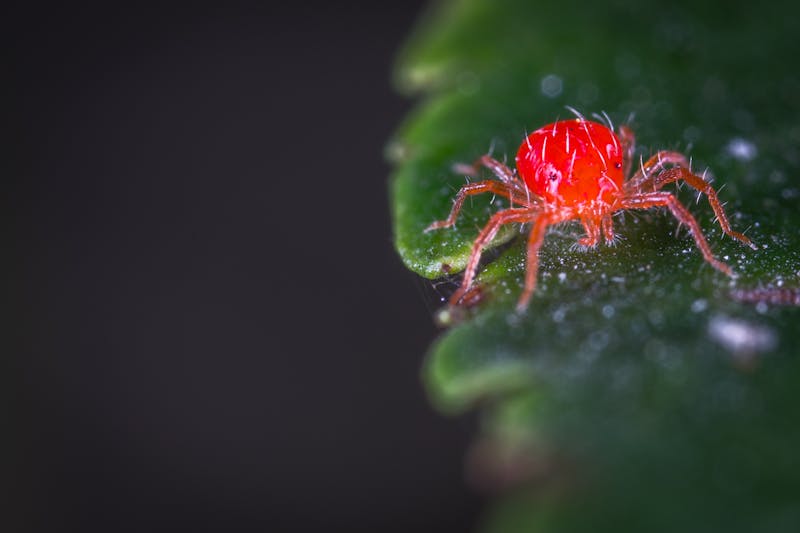If you’ve ever noticed tiny specks on your indoor plants that look like dust, but somehow aren’t, chances are you’ve got an unwanted guest: spider mites. These sneaky little critters may seem harmless at first, but they can cause some serious damage if left unchecked.
So, let’s dive into the fascinating world of spider mites and learn how they find their way onto your beloved houseplants. Don’t worry—I’ve got all the juicy details for you!
What Are Spider Mites?
Before we jump into how they get there, let’s do a quick rundown of who we’re dealing with. Spider mites are tiny, eight-legged arachnids that are so small, they’re almost impossible to see with the naked eye.
They’re usually around 0.5 millimeters in size, which makes them almost microscopic! Most people first notice them when they start seeing fine webbing on their plants (hence the “spider” part of their name) or when their plant’s leaves start to look discolored or speckled.
Spider mites love to feast on the juices of your plants, using their piercing-sucking mouthparts to draw out nutrients. But how on earth do these sneaky pests end up on your indoor plants? Let’s take a look!
The Journey of a Spider Mite
They Hitch a Ride on New Plants
If you’ve recently added a new plant to your collection, there’s a good chance you’ve unknowingly brought in a few spider mites along for the ride. Spider mites are expert hitchhikers, traveling from one plant to another in the blink of an eye.
Even if you don’t see them at first, they can easily hide in the nooks and crannies of your plant’s leaves or soil, just waiting to settle into their new home. This is why it’s always a good idea to quarantine new plants for a few weeks to make sure they’re pest-free.
Through Airborne Travel
Spider mites are not just content with walking; they’re also pretty good at flying—well, kind of. They use the wind to travel between plants.
If your indoor plants are in close proximity to one another, the mites can simply float from one to the next, drifting on air currents like little parasitic stowaways. This is especially true if your home has a lot of open windows or doors that let in a breeze.
On Your Hands, Clothes, or Pets
Don’t forget that you’re part of the equation too! You might unknowingly be transporting spider mites from one plant to another simply by touching them. If you’ve recently handled a plant that’s infested, those little mites could hitch a ride on your fingers or clothing and find their way to a fresh plant.
Even your pets can unknowingly play the part of a delivery service, transporting mites from plant to plant as they wander through your home. So, next time you’re handling your green friends, give your hands a quick wash afterward, just to be on the safe side.
Through Poor Plant Care Habits
Believe it or not, spider mites love a warm, dry environment. If your plants are in a location that’s too hot, too dry, or both, they’re much more susceptible to these pests.
Spider mites thrive in these conditions and will multiply rapidly if they find the perfect setting. So, if your plants are already under stress due to low humidity or inconsistent watering, they become an easy target for spider mites looking to set up camp.
How to Prevent Spider Mites
Now that we know how these little invaders can get to your plants, let’s talk prevention. Fortunately, there are simple steps you can take to keep your plants safe:
- Inspect New Plants: Always check new plants carefully for signs of pests before bringing them into your home. Look for webbing, discolored leaves, or tiny dots that could be spider mites.
- Increase Humidity: Spider mites hate humidity, so keeping your plants in a more humid environment can help deter them. Try using a humidifier or regularly misting your plants.
- Keep Things Clean: Regularly wipe down your plants’ leaves with a damp cloth to remove dust, webs, and potential spider mites. This also helps your plants to breathe better!
- Use Natural Pesticides: If you notice an infestation, don’t panic! There are plenty of natural ways to control spider mites, such as neem oil, insecticidal soap, or a simple water spray. Be sure to treat your plants thoroughly, especially the undersides of the leaves where mites love to hide.
In Conclusion
Spider mites may be small, but they’re certainly mighty when it comes to causing damage to your plants. By understanding how they find their way into your home, you can take the necessary steps to prevent an infestation before it happens. And if you do spot those pesky mites, don’t fret—now you know how to deal with them like a pro! Keep your plants happy, healthy, and mite-free with just a little extra care and attention.
